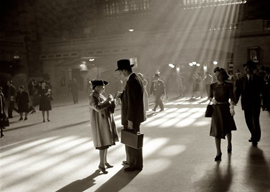
April 20, 2012

Grand Central Terminal, circa 1950.
NEW YORK—Seeing Manhattan rising from the distance is always a treat. I am not sure it’s possible for anyone brought up around these parts to appreciate entirely what New York—the idea of New York—meant to us who came from the Old Continent. I was eleven years old and had seen only war and devastation: dead, stinking bodies in the city parks, bullet-scarred buildings, and people starving on the sidewalks, too weak to die in the privacy of their hovels. Then I was suddenly whisked from home and into a TWA first-class Stratocruiser stopping in Rome, Paris, London, Shannon, Gander, Boston, and finally New York. I had fallen madly in love with the stewardess but quickly forgot all about her upon seeing Manhattan: the Empire State Building, the Chrysler Building, Grand Central Station, Fifth and Madison Avenue, high fashion on Park, money on Wall Street—this was no mere city but a romantic notion, a dream come true.
To this day, when seeing the place from afar, the frisson is there. Unlike Paris, New York has not fully emerged on canvas. Edward Hopper is the only man to capture the city’s moods and shadows, its loneliness and loveliness, its red-brick housing lined up like soldiers on parade, the fire escapes standing out like rifles. Paintings of the city are depictions of the real place, and no one except for Hopper has come close. That’s because New York is a novel and a movie, not a painting. New York is Henry James and Edith Wharton and F. Scott Fitzgerald, an imaginary mystical place rather than the Impressionist painting called Paris.
New York: The Movie is a black-and-white film in my memories. People rush about in a hurry. Time is money. Newspaper editors talk fast and from the side of their mouths. They bark orders at hat-wearing hacks. Women are beautiful and play up to the men. Mothers are worried and fathers are angry. Priests are nice and understanding, soldiers are honorable, cops are kind, and hookers are kindhearted.
In New York everyone is always in love, especially those college kids under the clock—the big clock in the Biltmore Hotel lobby next to Grand Central Station was the meeting place for college kids from 1900 onward, until some real-estate shark knocked the place down in 1981, and with it went a great city tradition.
Joe College would breeze into the Big City and head for the Biltmore. The first time I tried it I was still Joe Prep, wearing a Harris tweed jacket, grey flannels, and a striped tie around a blue button-down shirt. This was the uniform, the passport to acceptance from one’s peers, the password to the campus queen. College boys and girls tolerated preppies from the right prep school—just about. There was more snobbery under the clock than there is in any Wharton or James novels. One had to be in the right fraternity and play the right sport and wear the right thing and sound the right vowels—or one simply did not get the right girl. The snobbery was American, not English; it was Hemingway, not Waugh. It had to do with what an individual made of himself or herself, not what their parents had done with theirs. Hemingway admired toughies but also surrounded himself with the old guard like Winston and Raymond Guest and Billy Hitchcock. Waugh was a homosexual who fell in love with people’s backgrounds until he married into society. There lies the difference. I wonder what he would have been like under the clock at the Biltmore. His looks alone and lack of sporting prowess would have worked against him. One never knows.